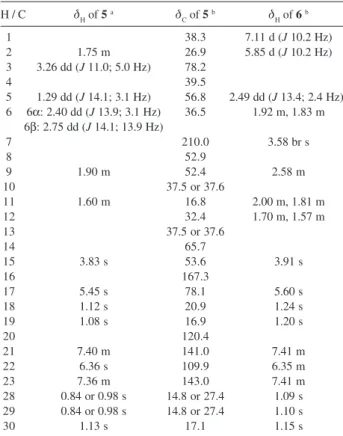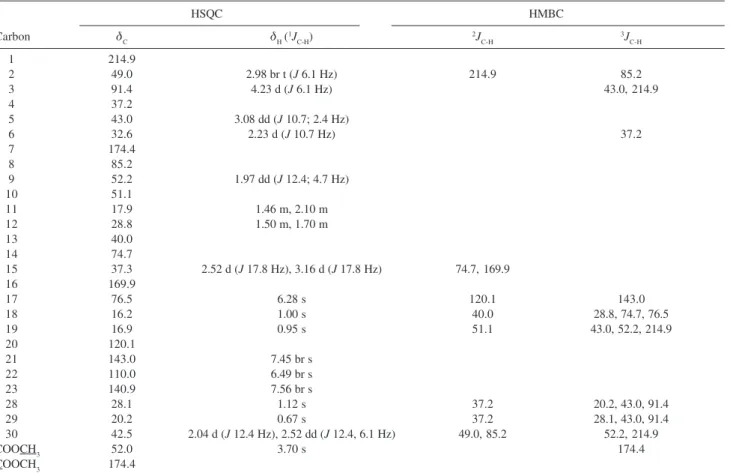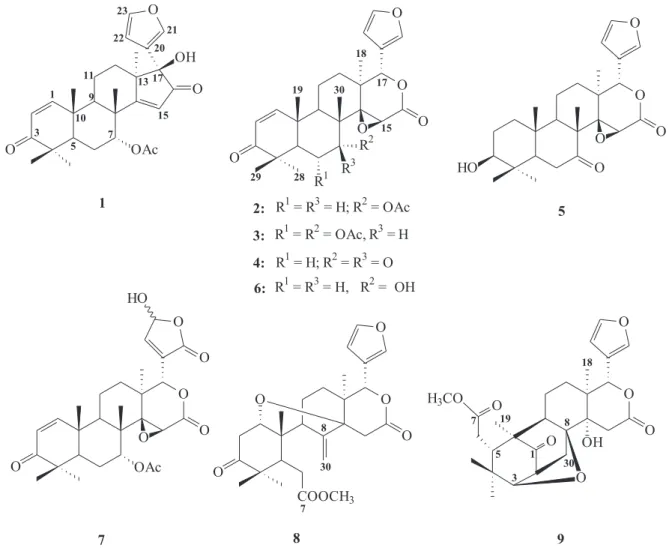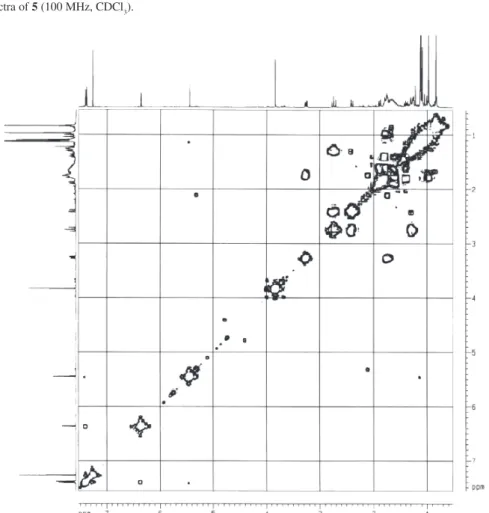J. Braz. Chem. Soc., Vol. 17, No. 3, 542-547, 2006. Printed in Brazil - ©2006 Sociedade Brasileira de Química 0103 - 5053 $6.00+0.00
Article
* e-mail: paulo@dq.ufscar.br
Limonoids from Andiroba Oil and
Cedrela fissilis
and their Insecticidal Activity
Alessandra R. P. Ambrozin,a Ana C. Leite,a Fabiana C. Bueno,b Paulo C. Vieira,*,a João B. Fernandes,a Odair C. Bueno,b M. Fátima das G. Fernandes da Silva,a
Fernando C. Pagnocca,b M. José A. Heblingb and Maurício Bacci Jr.b
a
Departamento de Química, Universidade Federal de São Carlos, CP 676, 13565-905 São Carlos - SP, Brazil
b
Centro de Estudos de Insetos Sociais, Universidade Estadual Paulista, CP 199, 13506-900 Rio Claro - SP, Brazil
Nove limonóides foram isolados de Carapa guianensis e Cedrela fissilis. Entre eles, a 1,2-diidro-3β-hidroxi-7-desacetoxi-7-oxogedunina é uma substância inédita. Além disso, alguns deslocamentos químicos da xilocensina k foram corrigidos e os dados de RMN 1H da 7-desacetilgedunina são descritos pela primeira vez na literatura. Seis dos limonóides isolados foram submetidos a ensaios com formigas Atta sexdens rubropilosa e apresentaram atividade inseticida moderada.
Nine limonoids were isolated from Carapa guianensis and Cedrela fissilis. Among them, 1,2-dihydro-3β-hydroxy-7-deacetoxy-7-oxogedunin is a new compound. Moreover, the assignments of some chemical shifts of xyloccensin k have been corrected and 1H NMR data of 7-deacetylgedunin have been assigned for the first time. These isolated limonoids were assayed on Atta sexdens rubropilosa workers showing moderate insecticidal activities.
Keywords: Meliaceae, Carapa guianensis, Cedrela fissilis, limonoids, insecticidal activity
Introduction
The family Meliaceae includes many plants that are sources of valuable timber and many that have wide-ranging uses in ethnomedicine. The family is distinguished by the occurrence of characteristic substances called limonoids.1 These substances have wide spectrum of
biological activities,2 particularly insecticidal action.3
The leaf-cutting ants of the genera Atta and Acromyrmex
use mostly fresh plant fragments to raise their symbiotic fungi4,5 and are the cause of considerable economic damage,
due to defoliationthat they cause.6 Control of this pest is
still problematic, presenting only temporary effects and is sometimes, harmful to the environment, to man and other animals.6,7 Consequently, an extensive search for alternate
methods to control these insects has been made in an attempt to substitute traditional agrochemicals with agents that yield faster decay, higher specificity and, therefore, less damaging to the environment. In this context, plants are considered a promising source for less toxic compounds that could be used as a soft control method.
As a part of our search for new natural insecticides against leaf-cutting ants8 and because of the fact that limonoids have
displayed biological activity towards a variety of insects, we decided to investigate the effect of limonoids isolated from two species of Meliaceae family, Carapa guianensis Aubl. and Cedrela fissilis Vell. on Atta sexdens rubropilosa.
Carapa guianensis is a tall tree that grows wild throughout South America, West India and South Africa. In Brazil, it can be found prevalently in areas of the Amazon rainforest, that are rich in soils and swamps. From the nuts of this plant is extracted an oil, called andiroba oil, which has a long history of traditional use in South America, such as analgesic, anti-inflammatory, insecticide, antibacterial, anti-parasitic and as an anti-cancer remedy.9-12
Andiroba oil is rich in fatty acids such as oleic, palmitic, stearic and linoleic acids, together with 2-5% of unsaponificable material. In addition, from several parts of Carapa guianensis have been isolated limonoids, triterpenes, steroids, coumarins, flavonoids and diglycerides.13-18
543 Limonoids from Andiroba Oil and Cedrela fissilis and their Insecticidal Activity
Vol. 17, No. 3, 2006
afforded the limonoids fissinolide, mexicanolide and 3β-hydroxyisomexicanolide.19
Extracts and fractions from C. fissilis and one commercial C. guianensis oil showed to have activity against A. sexdensrubropilosa workers.20,21 In the herein
study we report the insecticidal activities towards A. sexdens rubropilosa of six gedunin derivatives limonoids obtained from these active fractions besides spectroscopic data for 1,2-dihydro-3β-hydroxy-7-deacetoxy-7-oxogedunin (5), 7-deacetylgedunin (6) and xyloccensin k (9).
Results and Discussion
The chemical investigation of one commercial andiroba oil sample afforded seven limonoids: 17β-hydroxyazadiradione (1), gedunin (2), 6α -acetoxy-gedunin (3), 7-deacetoxy-7-oxogedunin (4), 1,2-dihydro-3β-hydroxy-7-deacetoxy-7-oxogedunin (5), methyl angolensate (8) and xyloccensin k (9). Moreover, from roots and leaves of C. fissilis were isolated 7-deacetyl-gedunin (6) and photogedunin (7) along with limonoids
2, 3, 4 and 5.
Compounds 1, 2 and 9 have been isolated for the first time from C. guianensis and all the limonoids isolated from C. fissilis are new for this species. Compound 5 is new to the literature.
Limonoids 1,22 2,233,134,15 7,24 and 825 were identified
by comparison of their NMR spectral data to those previously reported in the literature. The 1H NMR data of
compound 6 (Table 1) supplement and expand some hydrogen and carbon chemical shifts reported by Ekong and Olagbemi.26
Compound 5 was isolated as a white powder from
C. fissilis leaves and from andiroba oil and identified by spectroscopic methods. It is a new compound, whose 3-OH epimer was obtained from Guarea thompsonii.27
The 1H and 13C NMR spectra of 5 exhibited signals at: δH 7.40 (m), 7.36 (m), 6.36 (s) and δC 143.0, 141.0, 120.4,
109.9 of a β-furanyl ring; δH 1.13 (s), 1.12 (s), 1.08 (s),
0.98 (s), 0.84 (s) and δC 27.4, 20.9, 17.1, 16.9, 14.8 related
to five tert-methyl groups; δH 5.45 (s), 3.83 (s) and δC
167.3, 65.7, 53.6, 78.1 corresponding to a lactone D-ring with an epoxide between C-14 and C-15. These features are characteristics of compounds classified in the gedunin group of limonoids. However, the NMR spectra of compound 5 lacked signals related to the A-ring
α,β-insaturated ketone. In contrast, signals were observed at δH 3.26 (dd, 11.0 and 5.0 Hz) and δC 78.2. These signals
indicated an equatorial hydroxyl group at C-3. Thus, limonoid 5 was identified as 1,2-dihydro-3β -hydroxy-7-deacetoxy-7-oxogedunin and its spectral data allocations
(Table 1) were established unequivocally through 1D and 2D NMR experiments.
Compound 9 was isolated as a white powder from andiroba oil. It is classified as belonging to the mexicanolide group of limonoids and contains a tetrahydrofuran sub-unit with an oxygen bridge linking from C-3 to C-8. It was also isolated from the seed of
Xylocarpus granatum.28 However, we found through 2D
NMR spectra analysis that some chemical shifts were incorrectly determined by Kokpol et al.,28 among them
H-17, H-28, H-29, C-8, C-17, C-18 and C-29.
The chemical shift of C-17 was deduced from 1J
correlation between H-17 (δ 6.28, s) and one carbon at δ
76.5. H-18 (δ 1.00, s) was assigned through 3J correlation
between the methyl hydrogens and carbinolic carbon at δ
76.5 (C-17). Furthermore, H-28 (δ 1.12) and H-29 (δ 0.67) were determined through 3J correlation to C-3 (δ 91.4).
Finally, the 2J-3J correlations among H-30 (δ 2.52, dd,
12.4 and 6.1 Hz), H-2 (δ 2.98, br t, 6.1 Hz) and a quaternary carbon at δ 85.2 established C-8.
Some of the limonoids isolated from C. guianensis
and C. fissilis were evaluated for their effects on A. sexdens rupropilosa ants. The results (Table 3) showed that control and limonoid-treated groups had on average the same
Table 1. NMR spectral data of limonoids 5 and 6
H / C δH of 5
a δ
C of 5
b δ
H of 6 b
1 38.3 7.11 d (J 10.2 Hz)
2 1.75 m 26.9 5.85 d (J 10.2 Hz) 3 3.26 dd (J 11.0; 5.0 Hz) 78.2
4 39.5
5 1.29 dd (J 14.1; 3.1 Hz) 56.8 2.49 dd (J 13.4; 2.4 Hz) 6 6α: 2.40 dd (J 13.9; 3.1 Hz) 36.5 1.92 m, 1.83 m
6β: 2.75 dd (J 14.1; 13.9 Hz)
7 210.0 3.58 br s
8 52.9
9 1.90 m 52.4 2.58 m
10 37.5 or 37.6
11 1.60 m 16.8 2.00 m, 1.81 m
12 32.4 1.70 m, 1.57 m
13 37.5 or 37.6
14 65.7
15 3.83 s 53.6 3.91 s
16 167.3
17 5.45 s 78.1 5.60 s
18 1.12 s 20.9 1.24 s
19 1.08 s 16.9 1.20 s
20 120.4
21 7.40 m 141.0 7.41 m
22 6.36 s 109.9 6.35 m
23 7.36 m 143.0 7.41 m
28 0.84 or 0.98 s 14.8 or 27.4 1.09 s 29 0.84 or 0.98 s 14.8 or 27.4 1.10 s
30 1.13 s 17.1 1.15 s
aSpectra acquired in CDCl
3 at 400 MHz;
bSpectra acquired in CDCl 3 at
544 Ambrozin et al. J. Braz. Chem. Soc.
survival medium time. Compound 3 showed significant difference to the control according to the log-rank test (p < 0.05), which takes into account the whole test period. The gedunin type limonoids do not seem to be highly active against these ants. Indeed, C-seco limonoids, such as azadirachtin, are more active insecticidal compound, possessing both antifeedant and growth-regulating activities.2,29 The toxicity for the ants observed for the
C. fissilis and C. guianensis extracts seems not to be related only to the presence of the limonoids. Perhaps the limonoids act in synergism between them or with other compounds in the extracts.
Experimental
General experimental procedures
The 1H NMR, 13C NMR and 2D correlation spectra
were obtained in CDCl3 using Bruker DRX-200 and ARX-400 NMR spectrometers, and using tetramethylsilane (TMS) as internal standard. HPLC was carried out using a preparative LC-8A Shimadzu system with SPD-6AV Shimadzu UV detector.
Plant material
The roots and leaves of Cedrela fissilis Vell. were collected in São Carlos-SP, Brazil in June 01, 2001 and identified by Dr. Maria Inês Salgueiro Lima from the Department of Botany, Universidade Federal de São Carlos, where a voucher specimen (6701) was deposited. The commercial andiroba oil sample was purchased in Belém city (Pará, Brazil), in 1996.
Isolation of the limonoids from Carapa guianensis
A portion of andiroba oil sample (21.0 g) was submitted to vacuum liquid chromatography (VLC) on silica gel (70-230 mesh) using a hexane-CH2Cl2 -EtOAc-MeOH gradient, to yield the four corresponding fractions (H, D, Ac, Me). The fraction Ac (2.6 g) was subjected to column chromatography over silica gel (230-400 mesh, 267 x 38 mm i.d., stepwise with a hexane→MeOH gradient) to give three fractions. The second fraction (Ac2; 2.3 g) was chromatographed on a silica gel column (230-400 mesh, 264 x 45 mm i.d.) and eluted with solvents of increasing polarity
Table 2. NMR spectral data of limonoid 9
HSQC HMBC
Carbon δC δH (
1J C-H) 2J C-H 3J C-H 1 214.9
2 49.0 2.98 br t (J 6.1 Hz) 214.9 85.2
3 91.4 4.23 d (J 6.1 Hz) 43.0, 214.9
4 37.2
5 43.0 3.08 dd (J 10.7; 2.4 Hz)
6 32.6 2.23 d (J 10.7 Hz) 37.2
7 174.4
8 85.2
9 52.2 1.97 dd (J 12.4; 4.7 Hz)
10 51.1
11 17.9 1.46 m, 2.10 m
12 28.8 1.50 m, 1.70 m
13 40.0
14 74.7
15 37.3 2.52 d (J 17.8 Hz), 3.16 d (J 17.8 Hz) 74.7, 169.9
16 169.9
17 76.5 6.28 s 120.1 143.0
18 16.2 1.00 s 40.0 28.8, 74.7, 76.5
19 16.9 0.95 s 51.1 43.0, 52.2, 214.9
20 120.1
21 143.0 7.45 br s
22 110.0 6.49 br s
23 140.9 7.56 br s
28 28.1 1.12 s 37.2 20.2, 43.0, 91.4
29 20.2 0.67 s 37.2 28.1, 43.0, 91.4
30 42.5 2.04 d (J 12.4 Hz), 2.52 dd (J 12.4, 6.1 Hz) 49.0, 85.2 52.2, 214.9
COOCH3 52.0 3.70 s 174.4
COOCH3 174.4
545 Limonoids from Andiroba Oil and Cedrela fissilis and their Insecticidal Activity
Vol. 17, No. 3, 2006
(hexane→MeOH) yielding five fractions. Limonoid 5
(Ac2,4,2; 17.7 mg) was isolated from fraction four (Ac2,4; 458.2 mg) using column chromatography over silica gel (230-400 mesh, 444 x 24 mm i.d., stepwise with a hexane:CH2Cl2:acetone→MeOH gradient). The fifth fraction (Ac2,4,5; 409.0 mg) of this last step was subjected to column chromatography over silica gel (230-400 mesh, 475 x 24 mm i.d., stepwise with a hexane:CH2Cl2:acetone→MeOH gradient) to give seven fractions. Fraction three (Ac2,4,5,3; 19.8 mg) was subjected to preparative HPLC (Hypersil 5µ column, 290 x 10 mm i.d., eluted with hexane:isopropanol (9:1), flow rate: 3 mL min-1, detector UV at 240 nm) and the
limonoid 9 (Ac2,4,5,3,4; 2.7 mg) was isolated. Another portion of the andiroba oil sample (150.0 g) was submitted to VLC on silica gel (70-230 mesh) using a hexane-CH2Cl2-EtOAc-MeOH gradient, to yield four fractions (FH, FD, FA, FM). Fraction FA (19.0 g) was subjected to column chromatography over silica gel (230-400 mesh, 309 x 38 mm i.d., stepwise with a hexane:CH2Cl2:acetone→MeOH gradient) to give nine fractions. Several chromatographies of fractions five, seven and eight (FA5, FA7 and FA8) afforded limonoids 1, 2, 3, 4, 8, as described below.
The fifth fraction (FA5; 1.1 g) was chromatographed on a silica gel column (230-400 mesh, 269 x 32 mm i.d.) and eluted with solvents of increasing polarity (hexane:CH2Cl2:acetone→MeOH) to afford nine fractions. The limonoids 2 (FA5,6,4; 4.5 mg) and 3
(FA5,6,3; 1.5 mg) were isolated from fraction six (FA5,6; 30.1 mg) by preparative HPLC (Asahipak GS-310 2G polymeric column, 500 x 22 mm i.d., eluted with MeOH (100%), flow rate: 5 mL min-1, detector UV at 220 nm).
Fraction seven (FA7; 338.4 mg) was chromatographed on a silica gel column (230-400 mesh, 466 x 24 mm i.d.) and eluted with solvents of increasing polarity (hexane:CH2Cl2:acetone→MeOH) to afford seven fractions. The fourth fraction (FA7,4; 164.0 mg) was subjected to column chromatography over silica gel (230-400 mesh, 420 x 24 mm i.d.) and eluted with solvents of increasing polarity (hexane:CH2Cl2:acetone→MeOH) to yield five fractions.
Through preparative HPLC (Asahipak GS-310 2G polymeric column, 500 x 22 mm i.d., eluted with MeOH (100%), flow rate: 5 mL min-1, detector UV at 220 nm) of
fraction two (FA7,4,2; 38.9 mg) were isolated the limonoids
4 (FA7,4,2,3; 5.8 mg) and 8 (FA7,4,2,4; 17.4 mg). Fraction eight (FA8; 342.9 mg) was chromatographed on a silica gel column (230-400 mesh, 342 x 24 mm i.d.) and eluted with solvents of increasing polarity (hexane:CH2Cl2:acetone→MeOH) to afford six fractions. The fourth fraction (FA8,4; 195.4 mg) was subjected to column chromatography over silica gel (230-400 mesh, 473 x 24 mm i.d.) and eluted with solvents of increasing polarity (CH2Cl2:acetone→MeOH) to yield nine fractions. Limonoid
1 (FA8,4,6,2; 6.6 mg) was isolated from fraction six (FA8,4,6; 15.3 mg) through preparative HPLC (Hypersil 5m column, 290 x 10 mm i.d., eluted with hexane:isopropanol (9:1), flow rate: 3 mL min-1, detector UV at 240 nm).
Isolation of the limonoids from Cedrela fissilis
The powdered air-dried roots from C. fissilis were extracted by maceration for three times (72 h) with hexane, dichloromethane and and/or methanol at room temperature. The solvent was removed under reduced pressure by rotary evaporation. A portion of the hexane extract (3.5 g) from roots of C. fissilis (RH) was submitted to VLC on silica gel (70-230 mesh) using a hexane-CH2Cl2-EtOAc-MeOH gradient. The ethyl acetate-soluble fraction (704 mg) was chromatographed on silica gel (230-400 mesh), and eluted with hexane-CH2Cl2-acetone (6:3:1) to give 5 fractions (A→E). Fraction E was twice chromatographed as above to give four fractions. Fraction
E-4 was submitted to HPLC [Asahipak GS-310 2G polymeric column, 500 x 22 mm i.d., eluted with MeOH (100%), at a flow rate of 5 mL min-1, detector UV at
254 nm] affording 2 (13.1 mg) and 3 (2.5 mg).
The powdered air-dried leaves from C. fissilis were extracted by maceration as described above. The CH2Cl2 extract (29.0 g) from leaves of C. fissilis (LH) was submitted to VLC as described to the hexane extract from roots (RH). The CH2Cl2-soluble fraction (6.0 g) was chromatographed on silica gel (70-230 mesh)-florisil (1:1), with a hexane-CH2Cl2-MeOH gradient to afford 9 fractions (A→I). Fraction D was three times chroma-tographed with hexane-CH2Cl2-MeOH (6:3.5:0.5) to give
4 (8.3 mg) and 6 (5.1 mg). Fraction I was also chromatographed three times over silica gel (230-400 mesh), eluted with hexane-CH2Cl2-acetone (7:2:1) yielding 9 fractions. Fraction I-3 was purified by HPLC [Hypersil 5 µ column, 290 x 10 mm i.d., eluted with hexane:isopropanol (8:2), flow rate: 2.5 mL min-1,
Table 3. Activities of gedunin limonoids on Atta sexdens rubropilosa
workers at 100 µg mL-1
Limonoid Survival median (S50) / days
2 8
3 8a
4 11
5 9
6 9
7 9
control 10
546 Ambrozin et al. J. Braz. Chem. Soc.
detector UV at 240 nm] to give 5 (1.2 mg). Fraction I-8
was chromatographed on Sephadex LH-20, with MeOH (100%) to afford 7 (10.3 mg).
1,2-dihydro-3β-hydroxy-7-deacetoxy-7-oxogedunin (5)
White powder; [α]D = - 72.8° (c 0.32, CH2Cl2); UV (CH2Cl2) λmax/nm: 236; IR (film) νmax/cm-1: 3054, 2986,
1741, 1709, 1265, 1029; 1H NMR (CDCl
3, 400 MHz):
Table 1; 13C NMR (CDCl
3, 100 MHz): Table 1.
Bioassays
The A. sexdens rubropilosa workers used in the assays were randomly removed from laboratory nests. They had a combined body mass of 20-25 mg. Before assaying the nests were supplied daily with leaves of Eucalyptus sp., oat seeds and occasionally with leaves of other plants such as Hibiscus
sp., Ligustrum sp. or rose petals. Fifty ants were randomly removed from the nests and distributed to five Petri dishes (ten ants each) for each treatment. During the assays the ants
were maintained on an artificial diet consisting of glucose (50 g L-1), bacto-peptone (10 g L-1), yeast extract (1.0 g L-1)
and agar (15 g L -1) in distilled water (100 mL).30 The diets
(0.4-0.5 g per dish) with the addition of limonoids (experiment) or without (control) were supplemented daily in small plastic caps. The control was prepared with the diet and the solvent. The compounds were poured into the hot diet immediately after it was autoclaved. The final concentration of the limonoids added to the diet was 100 µg mL-1. To ensure that undetectable remaining amounts of the
solvent did not affect the ants, a comparison was made with another set of dishes in which water was used instead of solvent. As expected, the same survival rates were obtained with both systems (data not shown). During the assays the material was maintained in an incubator at a temperature of 25 (±1) oC and relative humidity ranging between 70-80%.
The maximum length of observation was 25 days and the number of dead ants was recorded daily.
The survival average 50% (S50) was calculated and survival curves were compared by the computer-assisted software Graph-Pad TM using the log-rank test.
547 Limonoids from Andiroba Oil and Cedrela fissilis and their Insecticidal Activity
Vol. 17, No. 3, 2006
Acknowledgments
The authors are grateful to Dr. Maria Inês Salgueiro Lima for collecting and identifying the C. fissilis specimen and to the Conselho Nacional de Desenvolvimento Científico e Tecnológico (CNPq), Fundação de Amparo à Pesquisa do Estado de São Paulo (FAPESP), Coordenação de Aperfeiçoamento de Pessoal de Ensino Superior (CAPES) and Financiadora de Estudos e Projetos (FINEP) for the financial support.
Supplementary Information
Supplementary data are available free of charge as PDF file at http://jbcs.sbq.org.br
References
1. Da Silva, M. F. das G. F.; Gottlieb, O. R.; Dreyer, D. L.;
Biochem. Syst. Ecol.1984, 12, 299.
2. Champagne, D. E.; Koul, O.; Isman, M. B.; Scudder, G. G. E.; Towers, G. H. N.; Phytochemistry1992, 31, 337.
3. Champagne, D. E.; Isman, M. B.; Towers, G. H. N. In Insecticides of Plant Origin; Arnason, J.T.; Philogéne, B. J. R.; Morand, P., eds.; The American Chemical Society: Washington, 1989, pp. 95-109.
4. Hölldobler, B.; Wilson, E.O.; The Ants, Harvard University Press: Massachusetts, 1990.
5. Weber, N. A.; Gardening Ants, the Attines, The American Philosophical Society: Philadelphia, 1972.
6. Della-Lucia, T. M. C.; Fowler, H.G. In As Formigas Cortadeiras; Della-Lucia, T. M. C., ed.; Folha de Viçosa: Viçosa, 1993, pp. 1-3. 7. Williams, D. F. In Applied Myrmecology: A World Perspective; Vander-Meer, R. K.; Jaffe, K.; Cedeno, A., eds., Westview Press: San Francisco, 1990, pp. 493-495.
8. Acácio-Bigi, M. F. M.; Hebling, M. J. A.; Bueno, O .C.; Pagnocca, F. C.; Silva, O. A.; Fernandes, J. B.; Vieira, P. C.; Rev. Bras. Entomol. 1998, 41, 239; Monteiro, M. R.; Torkomian, V. L. V.; Pagnocca, F. C.; Vieira, P. C.; Fernandes, J. B.; Da Silva, M. F. das G. F.; Bueno, O. C.; Hebling, M. J. A.; An. Acad. Bras.Cienc.1998, 70, 733; Pagnocca, F. C.; Ribeiro, S. B.; Torkomian, V. L. V.; Hebling, M. J. A.; Bueno, O. C.; Silva, O. A.; Fernandes, J. B.; Vieira, P. C.; Ferreira, A. G.; J. Chem. Ecol.1996, 22, 1325; Ribeiro, S. B.; Pagnocca, F. C.; Victor, S. R.; Bueno, O. C.; Hebling, M. J. A.; Bacci-Júnior, M.; Silva, O. A.; Fernandes, J. B.; Vieira, P. C.; An. Soc. Entomol. Brasil1998, 27, 421; Rodrigues-Gamboa, T. P.; Victor, S. R.; Fernandes, J. B.; Rodrigues-Filho, E.; Da Silva, M. F. G. F.; Vieira, P. C.; Pagnocca, F. C.; Bueno, O. C.; Hebling, M. J. A.; Castro, O. C.; Phytochemistry2000, 55, 837; Leite, A. C.; Bueno, F. C.; Oliveira, C. G.; Fernandes, J. B.; Vieira, P. C.; Da Silva, M. F.das G. F.; Bueno, O. C.; Pagnocca, F. C.; Hebling, M. J. A.; Bacci-Júnior, M.; J. Braz. Chem. Soc.2005, 16, 1391.
9. Bickii, J.; Njifutie, N.; Foyere, J. A.; Basco, L. K.; Ringwald, P.; J. Ethnopharmacol. 2000, 69, 27.
10. Gilbert, B.; Teixeira, D. F.; Carvalho, E. S.; Paula, A. E. S.; Pereira, J. F. G.; Ferreira, J. L. P.; Almeida, M. B. S.; Machado, R. S.; Cascon, V.; An. Acad. Bras. Cienc.1999, 71, 265. 11. MacKinnon, S.; Durst, T.; Arnason, J. T.; J. Nat. Prod. 1997,
60, 336.
12. Moura, M. D.; Souza-Silva, J.; De Oliveira, R. A. G.; Diniz, M. F. F. M.; Barbosa-Filho, J. M.; Acta Farm. Bonaerense2002,
27, 61.
13. Lavie, D.; Levy, E. C.; Zelnik, R.; Bioorg. Chem. 1972, 2, 59. 14. Marcelle, B. G.; Moto, B. S.; Phytochemistry 1975, 14, 2717. 15. Ollis, W. D.; Ward, A. D.; De Oliveira, H. M.; Zelnik, R.;
Tetrahedron 1970,26, 1637.
16. Ollis, W. D.; Ward, A. D.; Zelnik, R.; Tetrahedron Lett. 1964,
37, 2607.
17. Qi, S. H.; Wu, D. G.; Ma, Y. B.; Luo, X. D.; Acta Bot. Sin. 2003, 45, 1129; Qi, S. H.; Wu, D. G.; Zhang, S.; Luo, X. D.;
Pharmazie 2004, 59, 488.
18. Trindade, M. B.; Msc. Dissertation, Universidade Federal de São Carlos, Brazil, 2000.
19. Zelnik, R.; Tetrahedron Lett.1966, 52, 6441; Zelnik, R.;
Phytochemistry1970, 10, 1955.
20. Ambrozin, A. R. P.; Msc. Dissertation, Universidade Federal de São Carlos, Brazil, 2000.
21. Bueno, F. C.; Godoy, M.P.; Leite, A. C.; Bueno, O. C.; Pagnocca, F. C.; Fernandes, J.B.; Hebling, M. J. A.; Bacci Jr, M.; J. Appl. Ent., submitted.
22. Kraus, W.; Cramer, R.; Tetrahedron Lett.1978, 27, 2395. 23. Sierra, M. G.; Khalid, S. A.; Duddeck, H.; Fitoterapia1989,
60, 99; Khalid, S. A.; Duddeck, H.; Sierra, M. G.; J. Nat. Prod. 1989, 52, 922.
24. Céspedes, C. L.; Calderón, J. S.; King-Diaz, B. E.; Lotina-Hennsen, B.; J. Agric. Food Chem. 1998, 46, 2810.
25. Banergi, B.; Nigam, S.K.; Fitoterapia1984, 55, 3.
26. Ekong, D. E. U.; Olagbemi, E. O.; Tetrahedron Lett.1967, 36, 3525.
27. Housley, J. R.; King, F. E.; King, T. J.; Taylor, P. R.; J. Chem.
Soc., C1962, 5095.
28. Kokpol, U.; Chavasiri, W.; Tip-Pyang, S.; Veerachato, G.; Zhao, F.; Simpson, J.; Weavers, R. T.; Phytochemistry1996,
41, 903.
29. Govindachari, T. R.; Narasimhan, N. S.; Suresh, G.; Partho, P. D.; Gopalakrishman, G.; Kumari, G. N. K.; J. Chem. Ecol.1995,
21, 1585.
30. Bueno, O. C.; Morini, M. S. C.; Pagnocca, F. C.; Hebling, M. J. A.; Silva, O. A.; An. Soc. Entomol. Bras.1997, 26, 107.
Received: November 16, 2004
Published on the web: April 7, 2006
J. Braz. Chem. Soc., Vol. 17, No. 3, 1-9, 2006. Printed in Brazil - ©2006 Sociedade Brasileira de Química 0103 - 5053 $6.00+0.00
Supplementary Information
* e-mail: paulo@dq.ufscar.br
Limonoids from Andiroba Oil and
Cedrela fissilis
and their Insecticidal Activity
Alessandra R. P. Ambrozin,a Ana C. Leite,a Fabiana C. Bueno,b Paulo C. Vieira,*,a João B. Fernandes,a Odair C. Bueno,b M. Fátima das G. Fernandes da Silva,a
Fernando C. Pagnocca,b M. José A. Heblingb and Maurício Bacci Jr.b
a
Departamento de Química, Universidade Federal de São Carlos, CP 676, 13565-905 São Carlos - SP, Brazil
b
Centro de Estudos de Insetos Sociais, Universidade Estadual Paulista, CP 199, 13506-900 Rio Claro - SP, Brazil
2 Ambrozin et al. J. Braz. Chem. Soc.
Figure S2. NMR 13C spectra of 5 (100 MHz, CDCl 3).
3 Limonoids from Andiroba Oil and Cedrela fissilis and their Insecticidal Activity
Vol. 17, No. 3, 2006
Figure S4. COSY 1H-1H 45° spectra of 5 (400 MHz, CDCl 3) B.
4 Ambrozin et al. J. Braz. Chem. Soc.
Figure S6. Correlation map HMBC of 5 (400 MHz, CDCl3) A.
5 Limonoids from Andiroba Oil and Cedrela fissilis and their Insecticidal Activity
Vol. 17, No. 3, 2006
Figure S8. NMR 1H spectra of 6 (400 MHz, CDCl 3).
6 Ambrozin et al. J. Braz. Chem. Soc.
Figure S10. NMR 1H spectra of 9 (400 MHz, CDCl 3).
7 Limonoids from Andiroba Oil and Cedrela fissilis and their Insecticidal Activity
Vol. 17, No. 3, 2006
Figure S12. COSY 1H-1H 45° spectra of 9 (400 MHz, CDCl 3) A.
8 Ambrozin et al. J. Braz. Chem. Soc.
Figure S14. Correlation map HSQC of 9 (400 MHz, CDCl3) A.
9 Limonoids from Andiroba Oil and Cedrela fissilis and their Insecticidal Activity
Vol. 17, No. 3, 2006
Figure S17. Correlation map HMBC of 9 (400 MHz, CDCl3) B.









